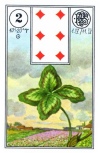How to Read Lenormand Card Combinations
Lenormand card combinations are based on your experience with the cards. The more you read Lenormand, the easier it will become for you to combine Lenormand cards.
For now, allow me to give you some tips to help speed things up for you. I’m going to assume you’ve already been practicing with single card spreads – learning the card’s meaning, how Lenormand speaks to you, and so on. So let’s begin…
Think of Lenormand Card Combinations as Adjectives and Nouns in a Sentence.
Just as an adjective describes the noun next to it, each card describes the cards next to it. The first card in a Lenormand pair is the noun, and the card after it is the adjective, that is it gives you a little more information about the first card.
 |  | For example, let’s say you have the Rider (Cavalier) followed by the Clover. The Rider is the noun and the Clover is the adjective, telling you more about the Rider.
So you know the Rider usually means news…and next to it is the Clover which often means luck. If you put the two together, you have lucky news. |
 |  | If your combination is the Rider followed by the Clouds…again the Rider is the noun and the Clouds are the adjective giving you more information about the Rider.
What do the Clouds tells us about the news the Rider is bringing? Well, Clouds are uncertainty and confusion. When we combine it with the Rider, we get uncertain news or news that causes uncertainty. |
 |  | Here, we have the Rider-Scythe combination.
Since the Scythe cuts through things quickly, the Scythe tells us the Rider’s message could be news that comes quickly about an ending or separation. |
Feel free to use My Lenormand Card Index Page to find cards quickly as you learn, or on the go! There are no limits to the combinations you can come up with… your interpretations are only limited by your imagination!

This is a great inspiring article. I am pretty much pleased with your good work. you put really very helpful information.
Thank you, Anália. Happy you find the site helpful!
great thanks!
i was very nervous about a situation at the job.
but now i’ll study
looking forward for the rest combinations
this deck is adorable!
The two card readings have become so simple with the Noun/Adjective perspective – however, how would you interpret the third card in a 3 card spread? THank you!
Hi Patricia!!
Thank you so much for your comment!! I’m glad you find it useful! The third card in the spread would be read in conjunction with the 2nd card. Soo.. 1+2, then cards 2+3, and then cards 3+4, etc. This is only in a string reading though. You don’t chain these up in a Grand Tableau.
Cheers,
Stephen
Thank you Stephen, I enjoy your site. I have the same question as above from Patricia. Can you please give an example of chain reading , like 5 or more cards in a raw. And also an example how to read an Grand Tableau where we don’t chain up. I tried to join the Forum but had no luck. Example reading would be very helpful. Thanks